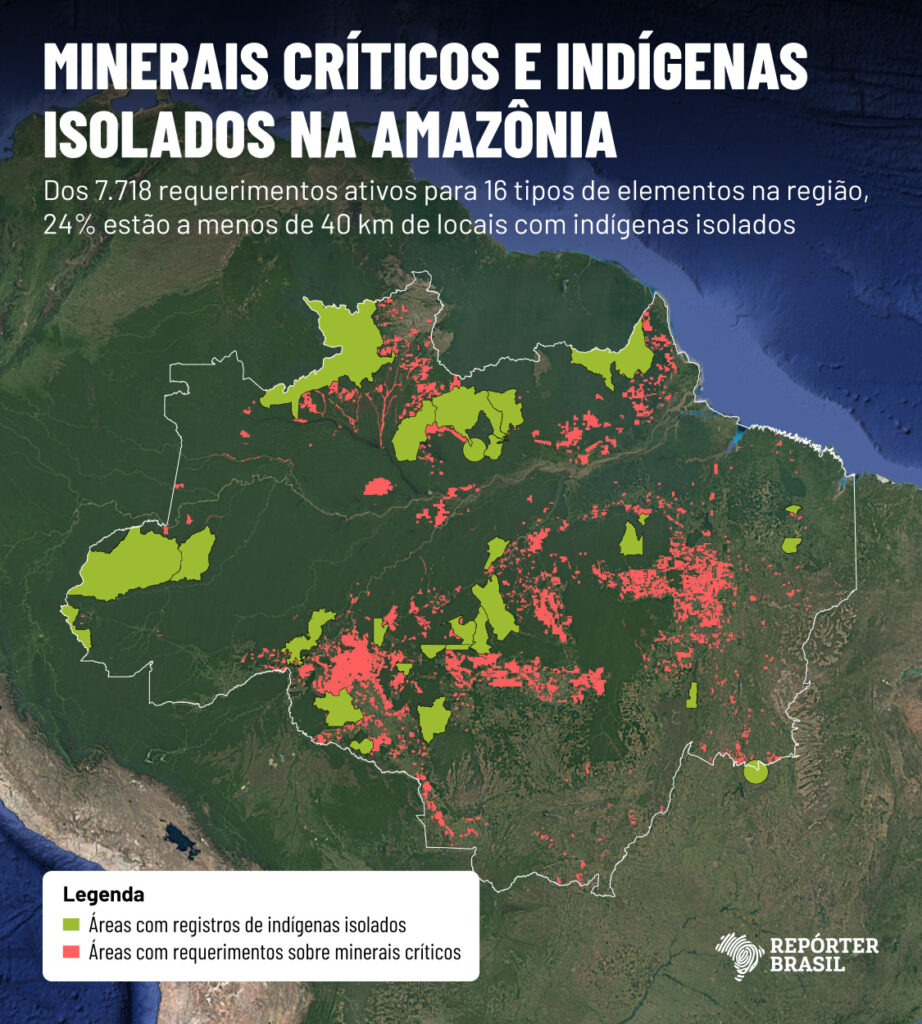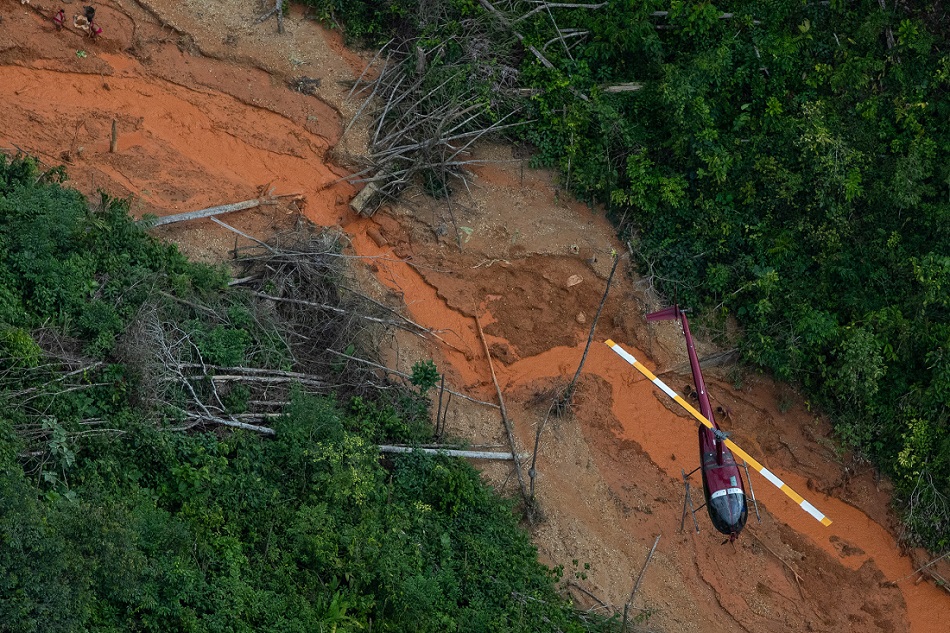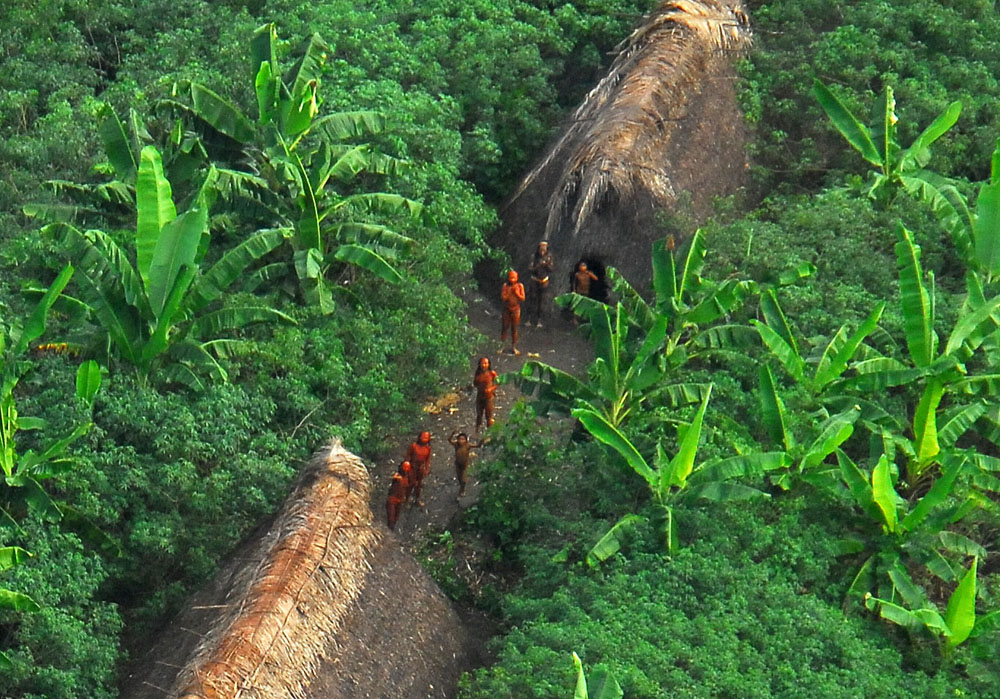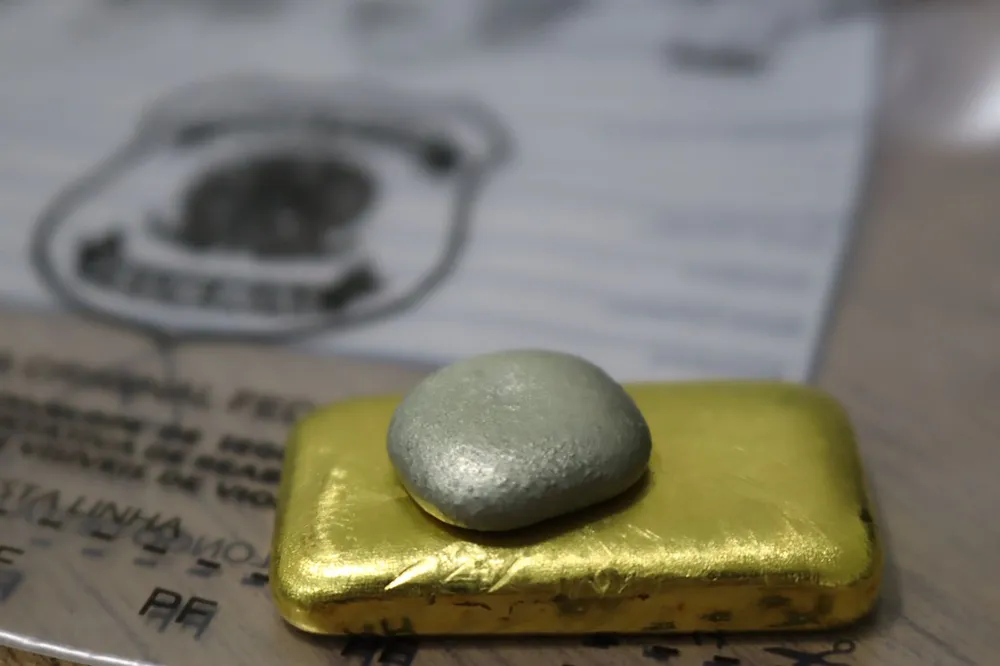MINING companies are seeking to explore minerals crucial to the technology sector close to at least 45 isolated Indigenous groups across Brazil’s Legal Amazon.
An exclusive Repórter Brasil investigation found 1,827 applications to mine copper, lithium, rare earths, and 13 other elements—materials used in products like microchips, wind turbines and electric vehicles—within 40 kilometers of these isolated communities.
Mining at this distance puts Indigenous populations at risk, says the Observatory of Isolated Indigenous Peoples (OPI), an advocacy group. “Isolation is a condition of survival, due to mining, road building and agribusiness,” explained anthropologist Miguel Aparício, OPI’s president, who has worked with isolated groups for more than thirty years.
The 40-kilometer rule is based on scientific research and environmental standards adopted by the OPI. For example, Interministerial Ordinance No. 60 of 2015 states projects like highways or dams can harm Indigenous territories if within this range. For mining, the regulation cites a 10-kilometer threshold, but OPI extends this to 40 kilometers due to isolated peoples’ heightened vulnerability.

ASSINE NOSSA NEWSLETTER
Most mining permits are at the exploration stage
Researchers identified 7,718 active mineral applications for 16 elements filed from 1953 through September 2025. Of these, 1,827—24%—are very close to areas where isolated Indigenous people live. In fact, 1,226 concern tin alone.
The data also show a recent spike in mineral exploration, with 3,392 permit requests—44% of the total—filed since 2020.
The survey found most permit applications—4,539, or 59%—are in the preliminary research stage, while another 2,369 (31%) are at the concession phase, authorizing extraction. Another 810 requests are classified as ‘available,’ meaning the land is open for new research or mining.
Repórter Brasil found these 1,827 mining requests affecting isolated peoples’ territories came from 567 entities—companies, cooperatives or individuals—including Anglo American Níquel Ltda, Vale and Bemisa (details below).
Over 80% of isolated Indigenous peoples in Brazil are surrounded by critical mineral projects
Brazil has the world’s highest concentration of isolated Indigenous peoples, with 115 officially recognized or believed to exist—all within the Legal Amazon. Of these, 29 groups have been confirmed, 26 are under review based on strong evidence, and another 60 are noted but lack confirmatory research.
Repórter Brasil analyzed only the 55 records already confirmed or under review. Of these, 45—81%—are within 40 kilometers of areas targeted by mining projects vital to the technology sector.
Among those affected are the Moxihatëtëa of Serra da Estrutura, an isolated community inside the Yanomami Indigenous Land. This area, already devastated by illegal gold mining, is surrounded by 228 mining applications for tin, niobium, tantalum and other minerals.
The Yanomami Indigenous Land is the second most affected, after the Amanã National Forest in Pará’s Tapajós basin. The Uru-Eu-Wau-Wau Indigenous Land in Rondônia, home to five isolated groups, is third. Here, ongoing threats from illegal tin mining are compounded by 224 permit applications for minerals key to modern technology.
Overall, 30 conservation areas and Indigenous territories with records of isolated peoples are affected. Some, like the Ituna Itatá and Munduruku Indigenous Lands in Pará, are already among the most deforested in the Amazon.
“The same territories threatened by deforestation and illegal mining also face pressure from a global rush for strategic minerals,” said anthropologist Luísa Girardi, an OPI advisor. “Mining projects nearby are undoubtedly a threat to isolated peoples. It’s not just illegal mining—legal operations are a danger, too.”
Major mining companies seek mining rights in isolated areas
According to Brazil’s National Mining Agency (ANM), Anglo American Níquel Ltda, a subsidiary of British mining giant Anglo American, leads with 83 active proceedings for copper exploration in Mato Grosso and Pará. None have reached the extraction phase.
In September, the company announced its merger with Teck to form “Anglo Teck,” positioning as “a global critical minerals champion and top five global copper producer,” according to the group.
Anglo American is a member of the Initiative for Responsible Mining Assurance (IRMA), committed to social and environmental responsibility. Under this framework, it announced in 2021 it would withdraw from all mining processes on Indigenous lands in Brazil.
Asked for comment, Anglo American said it holds “no licenses or plans to conduct exploration on Indigenous lands or in primary forests in Brazil.” The company did not address the potential consequences of its activities for isolated Indigenous groups.
Other major mining companies are also on the list. Vale, the largest in Brazil, maintains nine active applications for the exploration of tin, platinum, and nickel in Amazonas, Pará, and Rondônia, all less than 40 kilometers from four Indigenous lands with confirmed or strongly suspected isolated groups. Of these, seven are in the research phase, while the remaining two are available for new applicants.

In a statement to Repórter Brasil, Vale said it “has no active mining processes in the vicinity” of these Indigenous lands. The company said information on the National Mining Agency’s website “may be being updated, possibly resulting in inaccurate analysis,” and noted “processes renounced by Vale may still appear on the site.”
Bemisa Holding S.A., a mining group with operations across Brazil, is involved in 26 proceedings that impact isolated communities. The company recently was the winner of a public call for proposals from the National Bank for Economic and Social Development (BNDES) to support strategic mineral business plans.
When contacted, Bemisa said it “does not conduct any mining activities on Indigenous lands or in areas that could affect Indigenous peoples, including isolated communities.” See the companies’ full statements.
Repórter Brasil’s analysis, with support from the Pulitzer Center’s Rainforest Investigation Network, cross-referenced OPI data on isolated groups’ locations with mining applications for 16 critical minerals in the Amazon, listed in the National Mining Agency’s database. These include cobalt, copper, tin (cassiterite), graphite, lithium, niobium, nickel, platinum, silicon, thallium, tantalum, rare earths, titanium, tungsten, uranium and vanadium.
Leia também



